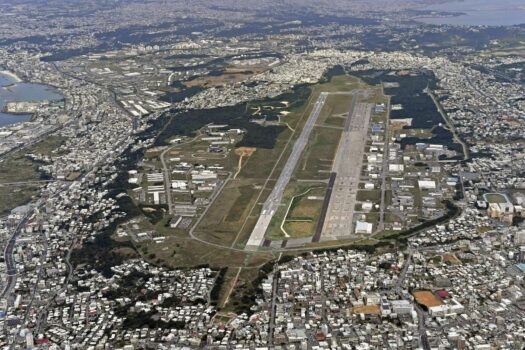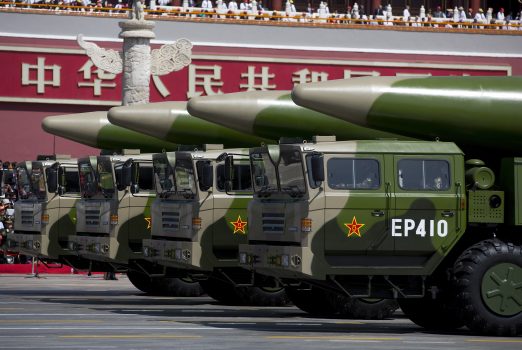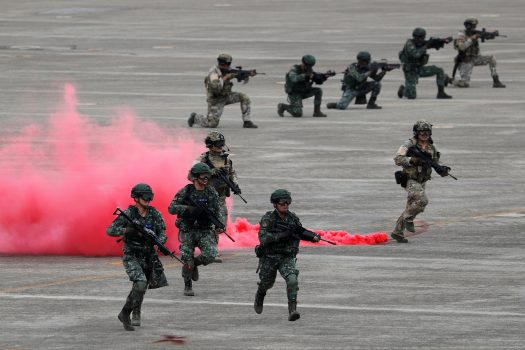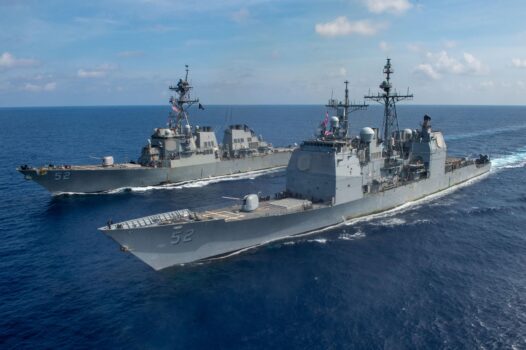The U.S. Air Force will struggle to maintain pressure on the Chinese military if conflict erupts around the Taiwan Strait, according to a recent war games analysis.
“F-22s and F-35s operating under ideal conditions at sophisticated home bases here in the United States, have an ‘operational readiness’ rate of about 60 percent,” Joseph Siracusa, adjunct professor of the political history of international diplomacy at Curtin University told The Epoch Times.
Operational readiness describes the ability of a military branch to operate and maintain its systems and procedures effectively.
The rate is critical as military engagements can run over weeks to months.
“If you want to run 40 sorties [attacking runs] a day, well, you do the math,” Siracusa added.
The professor, who has worked with war gaming models during the Cold War, said recent conflict simulations revealed that the sheer distance between the U.S.’s closest airbase in Kadena, Okinawa to Taiwan would be a deciding factor if a conflict broke out.

“Fighting a war almost within sight of the Chinese homeland will be a tough slog when the United States has only one land airbase within 700 miles of the battle area,” he said.
In January, Ellen Lord, the Trump-era undersecretary of defense for acquisition and sustainment said operational readiness for the advanced F-35 fleet was at 69 percent, well below the target of 80 percent, which was set by former Secretary of Defense James Mattis.
The low numbers follow years of Obama-era budget cuts to the military that saw army personnel reduced by 10 percent, and ballistic missile projects suspended or halted altogether.
Ironically, it will be missiles that play key role in keeping U.S. forces at bay, particularly for the first 60 days.
“F-22s and F-35s have very low radar signatures but the refuelling tankers have the radar cross-section of a large barn, making them very vulnerable to Chinese long-range anti-air missiles,” Siracusa said.
U.S. naval carriers would also be out of the question, given the reach of Chinese ballistic missile launchers the DF-21 and DF-26.

“We learned some lessons in Vietnam and the Persian Gulf where our naval carriers could operate just off-shore from the target areas and never be attacked,” Siracusa said. “That will not be the case in the Strait of Taiwan.”
Since the reelection of Taiwan President Tsai Ing-wen, the Chinese Communist Party (CCP) has ramped up its hostile rhetoric toward the island.
In recent months, Chinese military jets have also made near-daily incursions into Taiwanese airspace, with the largest being in late March, when 20 Chinese military planes entered Taiwan’s Air Defence Identification Zone.
U.S. Admiral Philip Davidson, head of U.S. Indo-Pacific Command issued a dire warning in response to the build-up, saying he believed Beijing could invade Taiwan “in the next six years,” while other analysts believe the timeframe could be shorter.
War Game Scenario
War game specialists like Siracusa believe the most likely war scenario surrounding Taiwan will begin with Beijing’s annual large-scale, amphibious landing drills normally conducted in October off the south-eastern coast of the mainland.
U.S. surveillance satellites begin picking up unusual activity, more troop movements than usual, and more realistic.
Beijing’s propaganda organs start working overtime to stir up national sentiment and indignation towards Taiwan, particularly at its dogged refusal to recognise CCP rule.
The United States responds by deploying bombers at its bases in Guam and Okinawa and increases naval patrols across Taiwan waters, which is already taking place.
U.S. surveillance pick up more worrying signs of PLA naval craft and amphibious forces marshalling on the opposite coast to Taiwan.

If an attack commences, it likely begins with a naval bombardment and airstrikes targeting Taiwanese airfields and military bases.
The United States retaliates with bombing raids targeting CCP ships, airfields, bases, and missile launch sites.
If desperate enough, Beijing escalates and targets Okinawa, Guam, or Hawaii with intermediate-range ballistic missiles or low-yield nuclear weapons.
Beijing Driven by Fear, Not Expansionism
But the professor concedes that wargaming scenarios are only as “strong as its weakest link.” In this case, the scenario hinges on the willingness of either country to strike or fire the first shot.
“Unfortunately, hubris sometimes trumps common sense,” he said.
Mark Beeson, professor of international politics at the University of Western Australia said the build-up of military forces was increasing the likelihood of a confrontation.
“China is digging itself a big hole, and it is difficult to get out of it without losing enormous amounts of face,” he told The Epoch Times.
“The chances of an accident, misjudgement or miscalculation are increasing by the day,” he added.
Siracusa also says any move by Beijing was “driven by fear and weakness, not strength or expansionism.”
“The expansionist story is a falsehood that the military-industrial complex tells each other as they go onto sell the latest weapon system,” he said.
“Having no control over Taiwan, will in fact, tell the rest of China that the CCP has lost control,” he added. “The Chinese are worried about how the Soviet Union disappeared after 74 years, there’s this old rule that after five generations, it is very hard to pass on communist zeal.”
The CCP is entering its 72nd year of control over China as of 2021.
Mustering the Defence of Taiwan
In recent weeks, Germany, France, the United Kingdom, and The Netherlands have dispatched warships to patrol the South China Sea, to accompany existing U.S. naval carriers. While the Philippines have sent fighter aircraft to patrol the skies over hundreds of Chinese fishing ships moored in the area.

John Mills, former director of cybersecurity policy, strategy, and international affairs at the Office of the Secretary of Defense, previously told The Epoch Times that the Biden administration should sell Taiwan “any weapons it asks for.”
Taiwan’s diplomatic mission in Washington D.C. said that it was investing significantly in “asymmetric capabilities,” including a major investment in long-range missiles that can strike deep into China.
Australia has adopted a similar strategy, as a deterrence against military aggression.
Meanwhile, the U.S. Embassy’s second-highest-ranking diplomat in Australia, Michael Goldman, revealed in a podcast hosted by The Australian National University (ANU) that Australia and the United States were working on “contingencies” around a potential outbreak of conflict over Taiwan.
 RSS Feed
RSS Feed















 April 8th, 2021
April 8th, 2021  Awake Goy
Awake Goy  Posted in
Posted in  Tags:
Tags: 













